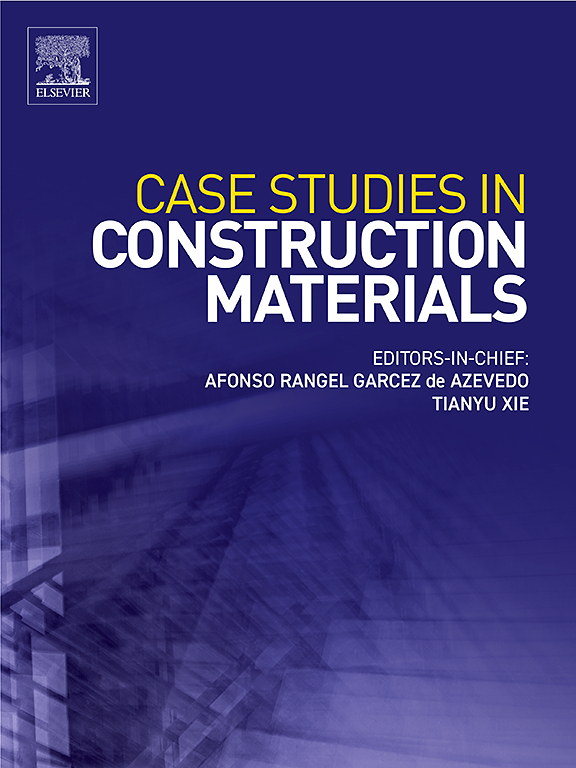Construction and field tests of jointed reinforced concrete pavement made of sea sand concrete and GFRP reinforcement
IF 6.6
2区 工程技术
Q1 CONSTRUCTION & BUILDING TECHNOLOGY
引用次数: 0
Abstract
The utilization of sea-sand concrete (SSC) reinforced with glass fiber reinforced polymer (GFRP) bars presents a viable solution to address both the scarcity of river sand resources and the corrosion susceptibility of conventional steel reinforcement in marine environments. This study presents a field case study of a stretch of jointed reinforced concrete pavement (JRCP) fabricated with GFRP bars and SSC in a port infrastructure project. Mechanical performance of the GFRP-SSC pavement system was investigated through early-age time-dependent behavior observations, vehicle load tests, and numerical analysis. Early-age analysis of the tested pavement section indicated that SSC exhibited greater expansion than river sand concrete (RSC) within the first 5 h after pouring. Additionally, an increased reinforcement ratio of GFRP bars was observed to mitigate concrete shrinkage. The results of vehicle load tests and numerical analysis demonstrate that the GFRP bars maintain relatively low stress level under the design vehicle load, and the stress induced by a single vehicle load is insufficient to cause cracking or failure of the GFRP-reinforced pavement. Then, the effects of design parameters, including the arrangement of GFRP bars, the thickness of the pavement slab, and the elastic modulus of the base layer, on the structural behavior of GFRP-SSC pavement were analyzed through a parametric study. Over all, the case study demonstrates that the GFRP-SSC pavement exhibits comparable working performance to steel reinforced RSC pavement, making it a viable alternative for construction of JRCP engineering in coastal and island regions.
海砂混凝土与玻璃钢配筋接缝混凝土路面施工及现场试验
利用玻璃纤维增强聚合物(GFRP)钢筋加固海砂混凝土(SSC)为解决海洋环境中河砂资源稀缺和传统钢筋易腐蚀的问题提供了一种可行的解决方案。本研究介绍了港口基础设施项目中一段由GFRP筋和SSC制成的接缝钢筋混凝土路面(JRCP)的现场案例研究。通过早期时效行为观察、车辆荷载试验和数值分析,研究了GFRP-SSC路面系统的力学性能。早期龄期分析表明,在浇筑后的前5 h内,SSC比河砂混凝土(RSC)表现出更大的膨胀。此外,观察到增加GFRP筋的配筋率可以减轻混凝土收缩。车辆荷载试验和数值分析结果表明,GFRP筋在设计车辆荷载作用下保持较低的应力水平,单个车辆荷载引起的应力不足以引起GFRP筋加筋路面的开裂或破坏。然后,通过参数化研究,分析了GFRP筋布置、铺装板厚度、基层弹性模量等设计参数对GFRP- ssc路面结构性能的影响。总体而言,案例研究表明,GFRP-SSC路面具有与钢筋RSC路面相当的工作性能,使其成为沿海和岛屿地区JRCP工程建设的可行替代方案。
本文章由计算机程序翻译,如有差异,请以英文原文为准。
求助全文
约1分钟内获得全文
求助全文
来源期刊

Case Studies in Construction Materials
Multiple-
CiteScore
7.60
自引率
19.40%
发文量
842
审稿时长
63 days
期刊介绍:
Case Studies in Construction Materials provides a forum for the rapid publication of short, structured Case Studies on construction materials. In addition, the journal also publishes related Short Communications, Full length research article and Comprehensive review papers (by invitation).
The journal will provide an essential compendium of case studies for practicing engineers, designers, researchers and other practitioners who are interested in all aspects construction materials. The journal will publish new and novel case studies, but will also provide a forum for the publication of high quality descriptions of classic construction material problems and solutions.
 求助内容:
求助内容: 应助结果提醒方式:
应助结果提醒方式:


